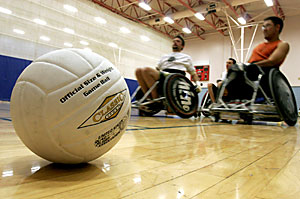 |
|
JOSH FIELDS/Arizona Daily Wildcat
|
The Arizona Quad Rugby team practices sprints at the Campus Recreation Center yesterday evening. The Quad Rugby team and other adaptive athletics programs are seeking funding by proposing a $1 to $1.50 program fee that could account for about one-third of their budget.
|
|
|
By Jennifer Amsler
Arizona Daily Wildcat
Wednesday, April 13, 2005
Print this
Fundraisers, not fees, will be key
The Adaptive Athletics department still needs money to keep wheelchair sports running at their current capacity, even though the idea to ask students for a $1 activity fee never appeared on the Associated Students of the University of Arizona ballot.
The athletes, most recently known for their fundraiser "Lame for a Game" that paired adaptive players with the able-bodied UA men's basketball team, do not receive any funding from the state and rely on private donors and fundraisers to keep the program afloat, said David-Herr Cardillo, the assistant director of the Disability Resource Center.
Herr-Cardillo approached the Associated Students of the University of Arizona Senate twice this academic year to present the idea for a $1 to $1.50 student activity fee, which could provide the program with a base amount of about $40,000 to $50,000. Total expenditures for all wheelchair sports are about $120,000 per year.
"But it's not going to happen this year," Herr-Cardillo said.
With other programs and departments also in need of additional funds, Herr-Cardillo said they will not push for a fee any time soon but instead are focusing on generating other sources of funds, including attempts to increase attendance to games and their two annual fundraisers.
The Jim Click "Run 'N' Roll" fundraiser, an eight-kilometer marathon that brings in $130,000 to $150,000, and "Lame for a Game," which brings in $30,000 to $40,000, could fund the program better if more students attended, Herr-Cardillo said.
The sports budget must stay in the black, and if the department does not have the funds to support the program, teams might be forced to enter fewer competitions, Herr-Cardillo said. Or worse, some of the teams could be cut entirely.
"Luckily, we haven't had to make that decision," he said.
Herr-Cardillo said a small activity fee could increase attendance at games because the student body would have a "sense of ownership" to the program.
The University of Texas, Arlington charges each student a small fee that goes directly toward their adaptive athlete program, and as a result, student turnout for games is huge, he said.
"There's definitely a social exchange going on there," Herr-Cardillo said.
The adaptive athletes department presented the idea of a fee to the ASUA Senate, and Herr-Cardillo said both presentations in November and March went well.
Erin Hertzog, an ASUA senator and executive vice president-elect, said the presentation was extremely organized, but the senate has not taken a stance about the possibility of a small fee.
"Fees are a touchy subject," said Hertzog, a journalism sophomore.
Hertzog said the senate will continue to work with the adaptive athletics department to help them find sources of funds.
The first presentation to the senate in November had a few senators voicing concerns about the possible fee that would charge all UA students but fund a program that only a few students could join.
Wheelchair basketball athlete Jamie Heckerman, an undeclared freshman, assisted Herr-Cardillo at the November's presentation to the senate and said adaptive athletics could use more financial support because the program is solid for students like her.
"It's something that helps us have a normal life," she said.
The program includes wheelchair track, quad rugby, tennis, men's and women's basketball, and goal ball, which is a sport for visually impaired students.
